Understanding the Importance of Fire Risk Assessments
This blog post outlines the process of a fire risk assessment and how they are conducted.
Ryan Morgan
9/12/20233 min read


Why Are Fire Risk Assessments Important?
Life Safety: The primary purpose of a fire risk assessment is to protect lives. By identifying fire hazards and implementing safety measures, you can significantly reduce the risk of injury or loss of life in the event of a fire.
Property Protection: Fires can cause extensive damage to buildings and assets. A thorough assessment helps in safeguarding your property and assets by identifying vulnerabilities and suggesting preventive measures.
Legal Compliance: Many countries and regions have regulations and laws in place that require businesses and property owners to conduct regular fire risk assessments. Compliance with these regulations is not only a legal requirement but also demonstrates your commitment to safety.
Insurance Requirements: Insurance companies often require businesses to perform fire risk assessments as part of their underwriting process. A well-documented assessment can lead to reduced insurance premiums, saving you money in the long run.
Business Continuity: Fire incidents can disrupt operations, leading to financial losses and reputation damage. A fire risk assessment helps you develop contingency plans and ensure business continuity in the face of such disasters.
Components of a Fire Risk Assessment
A typical fire risk assessment includes the following components:
Identification of Fire Hazards: This involves identifying potential sources of ignition, fuel, and oxygen that can lead to fires. Examples include faulty electrical wiring, flammable materials, and inadequate fire protection systems.
Evaluation of Fire Risks: Assessors analyze the likelihood and consequences of fires occurring. This helps in prioritizing risks based on severity and determining appropriate preventive measures.
Fire Safety Measures: Recommendations for fire safety measures may include installing fire alarms, fire extinguishers, emergency lighting, fire doors, and sprinkler systems. These measures aim to prevent fires, detect them early, and minimize their impact.
Emergency Procedures: Developing and implementing clear evacuation plans and emergency procedures is essential. Everyone on the premises should know how to react in the event of a fire.
Training and Education: Ensuring that occupants and staff receive proper training on fire safety is crucial. Regular drills and training sessions can make a significant difference in reducing the impact of a fire.
Documentation: A comprehensive report outlining the findings of the assessment, recommended actions, and timelines for implementation is a crucial part of the process. This documentation can be valuable for insurance purposes and legal compliance.


Fire is a destructive force that can cause immense harm to lives, property, and the environment. Whether you're a homeowner, a business owner, or responsible for a public space, taking precautions to prevent fires and minimize their impact is crucial. This is where a fire risk assessment comes into play. In this blog post, we will delve into the significance of fire risk assessments, their components, and why they should be an integral part of your safety strategy.
What is a Fire Risk Assessment?
A fire risk assessment is a comprehensive evaluation of a property or premises to identify potential fire hazards, assess the level of risk they pose, and determine appropriate measures to mitigate those risks. These assessments are conducted by trained professionals who carefully inspect the property and its operations to create a customized plan for fire prevention and safety.
Fire risk assessments are a cornerstone of fire safety, providing a systematic approach to identifying and mitigating potential hazards. By conducting regular assessments and implementing recommended safety measures, you can protect lives, property, and business interests. Remember, fire prevention is not just a legal obligation; it is a moral responsibility to keep everyone safe in your space. Don't wait for a fire to happen – act now and make fire risk assessments an integral part of your safety strategy.


Contacts
Office
7 Marshall Close
Hereford
HR4 0QF
Socials
01432 357772


Fire and Risk Management Services Ltd
Registered in England:
Company Number 1093933
07880 694802

